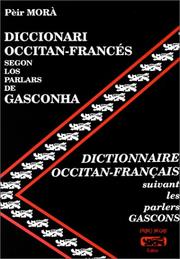| Listing 1 - 7 of 7 |
Sort by
|

ISBN: 2905007168 9782905007162 Year: 1994 Publisher: Gradignan: Princi negre,
Abstract | Keywords | Export | Availability | Bookmark
 Loading...
Loading...Choose an application
- Reference Manager
- EndNote
- RefWorks (Direct export to RefWorks)
A l'heure actuelle où l'écrit de Gascogne est assez répandu et facile à trouver, il fallait un dictionnaire, petit mais pas trop, maniable, de 15000 mots qui serve à quiconque recherche un mot pour s'aider à la lecture du parler gascon. L'auteur, Pierre Mora, né à Onesse-Laharie, écrit des nouvelles (Garbaias burlentas, Letras d'exilh) éditées chez Per Noste et chez Princi Negre et il traduit en gascon des textes en castillan et français. Il a mené un remarquable travail lexicographique pour réaliser ce dictionnaire, outil de base pour qui s'intéresse à la langue d'oc en Gascogne.
Gascon dialect --- Occitan language --- Dictionaries --- French. --- French --- Gascon (dialecte) --- Occitan (langue) --- Dialectes --- -Occitan language --- -Langue d'oc --- Languedoc language --- Provençal language, Modern --- Romance languages --- Provençal language --- -French --- -Dictionaries --- Gascon dialect - Dictionaries - French. --- Occitan language - Dictionaries - French
Book
ISBN: 3319244795 3319244817 Year: 2016 Publisher: Cham : Springer International Publishing : Imprint: Springer,
Abstract | Keywords | Export | Availability | Bookmark
 Loading...
Loading...Choose an application
- Reference Manager
- EndNote
- RefWorks (Direct export to RefWorks)
This book introduces readers to the concept and implementation of positioning techniques in the context of the wine industry. Featuring 30 case studies on brands and wine regions around the world - all based on the same principles - it presents a successful, cutting-edge strategy for the marketing of wine. Rather than focusing on a small group of elitist appellations, the Grand Crus universe and a handful of star brands, the book addresses the real, day-to-day wine world. In light of globalization, it introduces state-of-the-art wine positioning techniques, with an emphasis on the identity, segmentation and positioning of wine appellations and wine brands. In its analysis of wine appellation models, the book examines local parameters like geology, history and wine growing techniques; compares facts, figures and actors; analyzes the signals that are being sent to the market and presents a range of key factors for success. Similarly, the wine brands models are analyzed on the basis of their respective brand identity and apparent marketing policy. In the book’s final part, it summarizes recent developments in wine marketing, including the growing importance of wine brands as new territories in the global vineyard, and the role of appellations as the essence of cultural diversity.
Business. --- Marketing. --- Public relations. --- Globalization. --- Markets. --- Agriculture. --- Business and Management. --- Corporate Communication/Public Relations. --- Emerging Markets/Globalization. --- Wine tourism --- Advertising --- Wine industry --- Wine. --- Management --- Wine --- Alcoholic beverage industry --- Tourism --- Global cities --- Globalisation --- Internationalization --- International relations --- Anti-globalization movement --- Business --- Industries --- PR (Public relations) --- Industrial publicity --- Mass media and business --- Propaganda --- Publicity --- Farming --- Husbandry --- Industrial arts --- Life sciences --- Food supply --- Land use, Rural --- Consumer goods --- Domestic marketing --- Retail marketing --- Retail trade --- Industrial management --- Aftermarkets --- Selling --- Public relations --- Marketing --- Public markets --- Commerce --- Fairs --- Market towns
Book
Year: 1836 Publisher: Montpellier Jean Martel
Abstract | Keywords | Export | Availability | Bookmark
 Loading...
Loading...Choose an application
- Reference Manager
- EndNote
- RefWorks (Direct export to RefWorks)
Book
Year: 1914 Publisher: Paris Daragon
Abstract | Keywords | Export | Availability | Bookmark
 Loading...
Loading...Choose an application
- Reference Manager
- EndNote
- RefWorks (Direct export to RefWorks)
Book
ISBN: 9782212545579 Year: 2010 Publisher: Paris : Eyrolles Ed. d'Organisation,
Abstract | Keywords | Export | Availability | Bookmark
 Loading...
Loading...Choose an application
- Reference Manager
- EndNote
- RefWorks (Direct export to RefWorks)
Book
ISBN: 3319796348 9783319796345 Year: 2016 Publisher: Cham: Springer,
Abstract | Keywords | Export | Availability | Bookmark
 Loading...
Loading...Choose an application
- Reference Manager
- EndNote
- RefWorks (Direct export to RefWorks)
This book introduces readers to the concept and implementation of positioning techniques in the context of the wine industry. Featuring 30 case studies on brands and wine regions around the world - all based on the same principles - it presents a successful, cutting-edge strategy for the marketing of wine. Rather than focusing on a small group of elitist appellations, the Grand Crus universe and a handful of star brands, the book addresses the real, day-to-day wine world. In light of globalization, it introduces state-of-the-art wine positioning techniques, with an emphasis on the identity, segmentation and positioning of wine appellations and wine brands. In its analysis of wine appellation models, the book examines local parameters like geology, history and wine growing techniques; compares facts, figures and actors; analyzes the signals that are being sent to the market and presents a range of key factors for success. Similarly, the wine brands models are analyzed on the basis of their respective brand identity and apparent marketing policy. In the book's final part, it summarizes recent developments in wine marketing, including the growing importance of wine brands as new territories in the global vineyard, and the role of appellations as the essence of cultural diversity
Wine tourism --- Advertising --- Wine industry
Book
Year: 1945 Publisher: Rome Magi-Spinetti
Abstract | Keywords | Export | Availability | Bookmark
 Loading...
Loading...Choose an application
- Reference Manager
- EndNote
- RefWorks (Direct export to RefWorks)
| Listing 1 - 7 of 7 |
Sort by
|

 Search
Search Feedback
Feedback About UniCat
About UniCat  Help
Help News
News